Magnetocaloric materials reveal their magnetic charm to Andrew Turley
Fifteen years ago, a group of researchers in the US presented the world with a headline grabbing idea: a cooling unit that used magnets to reduce the temperature.
Among other benefits, the idea promised far greater energy efficiency and an end to harmful refrigerant gases, which have been messing with the atmosphere for years. Furthermore, many experts considered the key obstacles to commercialisation overcome. Indeed, some said that the first refrigerators, freezers and air conditioning units based on magnetic cooling might hit the market within five years.

Fast forward to the present and you can see that hasn’t happened. As is so often the case, there were more obstacles lurking around the corner. But a lot of chemistry has happened. And there’s evidence that - far from melting under the glare of commercial expectations - magnetic cooling has finally started to become pretty cool.
Keeping things cool is an important part of modern life. You can find refrigeration technology just about everywhere: in our homes, in our offices, in our hospitals, in our schools. The problem is that these cooling units consume a lot of energy - 15% of energy consumption worldwide is related to refrigeration. No one gave this much thought for much of the 20th century, when energy was considered cheap and plentiful. But in recent decades, the threat of climate change has prompted us to scrutinise the energy consumption of many everyday processes.
And when you analyse refrigeration, you find that it often isn’t very efficient. This isn’t surprising - we’ve been keeping things cool in more or less the same way for a long time - but it means we may need to rethink our approach.
How it works
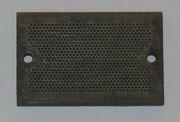
Magnetic cooling uses magnetocaloric (MC) materials, which heat up or cool down as you put them into or take them out of a magnetic field.
The key to this is unpaired electrons. A quantum mechanical property called spin gives every electron a magnetic field. You can think of each one as a tiny bar magnet with the usual north and south poles. Generally, electrons come in pairs. And when you pair up two electrons, their magnetic fields (sort of ) cancel each other out. The orbital containing the pair becomes magnetically the same from all directions.
But in some systems, electrons must go unpaired, leading to interesting magnetic properties. When you put an MC material into an external magnetic field, the dipoles associated with the unpaired electrons tend to align with the field and - importantly - the temperature of the material increases. Why does the temperature increase? The magnetic field forces the spins into a thermodynamically lower energy state, and the result of this is that thermal energy - heat - is expelled. When you take the material out of the field it cools down. Thermal energy is absorbed by the system to return the dipoles to a more disordered state. A good example of an MC material is gadolinium, which has seven unpaired electrons in its 4f orbitals, giving it an enormous magnetic moment.
Scientists have known about the effect for decades. It was first described in 1881 by German physicist Emil Warburg, who noted that the temperature of a sample of iron increased when he put it into a magnetic field.1 And it wasn’t long before engineers were thinking about how it might be harnessed to create a heat pump, a device that shifts heat from one place to another against the gradient.
The MC material, your refrigerant, starts off at the same temperature as its surroundings. Then, you apply a magnetic field and it heats up. You remove the excess heat using a heat sink of some kind - this might be water, or some other liquid, washing quickly over the material. Now that it’s the same temperature as everything else
again, you remove the field. This causes the temperature of the refrigerant to drop, and when it does you bring it into contact with the thing you want to cool. The refrigerant absorbs heat from that thing. Once they’re the same temperature, you remove the refrigerant and start again from the beginning. Each cycle pumps heat out, and, voila - you’re cooling with magnets.
The area heats up
It wasn’t until a string of key developments in the late 20th century, and the first few years of the 21st century, that interest in widespread application became significant.
In 1997, Vitalij Pecharsky and Karl Gschneidner at Ames Laboratory in Iowa, US, discovered that they could increase the MC effect in gadolinium by about 50% by alloying the metal with germanium and silicon.2 They called this the ’giant’ MC effect, because it was so much bigger than anything that had been seen before. In addition, the researchers found that they could change the Curie temperature (the temperature at which the MC effect is greatest) of the material, while maintaining the effect, by changing the amount of Ge and Si incorporated.3
This work was followed by a wave of new materials that were strongly MC at about room temperature. Then in 2001, the same researchers - in collaboration with Astronautics, a US avionic engineering firm based in Milwaukee - unveiled a room temperature prototype that used a permanent magnet as the source of the magnetic field instead of a superconductor magnet. It used gadolinium as the MC material and a rotational mechanism to move through the cooling cycle.
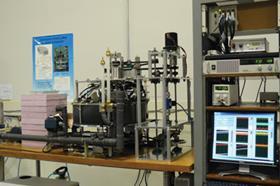
In the years that followed, interest took off. From 1997 to 2007, the number of papers published each year on the MC effect grew exponentially.4 By 2007, a paper on the MC effect was appearing in print every working day and conferences dedicated solely to magnetic refrigeration started appearing. Various groups have now demonstrated the potential of these materials within working technology, with around 40 prototypes having now been built in Asia, Europe and the US.
Jumping hurdles
But magnetic refrigeration has yet to become a commercial reality. One reason for the delay, explains Steve Russek, the director of systems engineering at Astronautics, is that the MC materials available when building their 2001 prototype weren’t ready for application because you couldn’t readily vary their Curie temperature.
At the Curie temperature, the spins change phase. Below it they are ordered in a magnetic field - above it disordered. The MC effect quickly vanishes as you rise above the Curie temperature. Why does this matter? Well, you can change the temperature of an MC material with a magnetic field - we know that - but it turns out you can’t change it very much. With even the most pliant materials, the temperature change amounts to only a few kelvin. But a domestic fridge, for example, might need to establish a temperature difference, or span, of 30K or 40K to be of use.
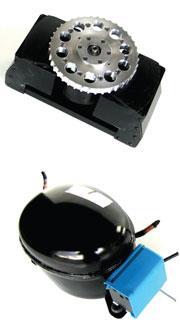
One way around this problem is to establish a temperature gradient across a series of MC components. The material of each component has the same elements, but the proportions vary, and this means the Curie temperature of each component is slightly different. Specifically, it drops by a few kelvin as you move from one component to its neighbour, from the warm end of the gradient to the cool end. Thus, when you cycle the whole series in and out of the magnetic field, the components all experience the same temperature change despite having different temperatures. This results in heat being pulled in at one end and - importantly - the same amount, plus a component relating to the work being done, being pushed out the other end.
Until 2002, most attention was focused on gadolinium and its alloys, says Neil Wilson, chief executive of UK-based magnetic cooling firm Camfridge. But gadolinium and germanium are expensive. Furthermore, he adds, the Ge-Si variants tended to suffer from hysteresis: the magnetism and demagnetism cycle was not fully reversible.
Other classes of materials have emerged in recent years. In 2002, a group at the University of Amsterdam in the Netherlands led by Ekkes Brück described a class of materials based on manganese, phosphorus, iron and arsenic.5 The properties of these materials were good, says Wilson, but it was unlikely to be embraced by an industry which has a natural aversion to putting arsenic anywhere near food.
In 2003, a group in Japan led by Tohoku University’s Asaya Fujita described a class of MC materials based on lanthanum, iron, silicon and hydrogen.6 These materials have since proved very popular and much work has been dedicated to their development.
Russek says that, in 2010, Astronautics ’put a major stake in the ground’ by demonstrating a temperature span of 13K using LaFeSiH materials. He adds: ’For meaningful application, you need to get to around 35K, and we’re well on the way to doing that. Our ability to get to that span is limited by the combination of materials availability and other aspects of machine design that need to be finished up.’
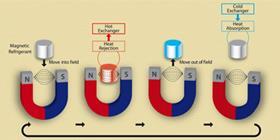
Meanwhile, Camfridge says that it has built a system with a span of 35K using LaFeSi materials doped with cobalt. The five person company, a spinout from the University of Cambridge, UK, has attracted the interest of appliance manufacturers with its technology.
The second reason Russek gives for the delay in commercialisation is problems scaling up the production processes for these materials. A problem that, he claims, is now largely resolved.
Wilson agrees, saying that in the last couple of years the materials have undergone an ’industrialisation’ of sorts - as groups have made breakthroughs in this area. Camfridge sources its MC material from Vacuumschmelze, a German company that specialises in magnetic materials. Vacuumschmelze has found a way of utilising the powder metallurgy process it uses to make permanent magnets to make the MC materials Camfridge needs. And crucially, the precise properties of the materials aren’t lost in scaling up.
’I wouldn’t want to say that all the industrialisation problems are solved,’ says Wilson. ’There are still some things to do. But the big change between 2002 and now is that now you can make tens of kilograms or more using standard production processes.’
Time for launch?
Camfridge has partnerships with three big domestic appliance manufacturers: the US giant Whirlpool, Turkish company Arçelik and the Italian firm Indesit.
Whirlpool is planning to launch a prototype domestic fridge, incorporating a Camfridge magnetic cooling unit, in July to coincide - rather intriguingly - with the London Olympic Games.
Motivation comes from the EU energy ratings for domestic appliances. The top rating is A+++, but according to Wilson, it isn’t possible for a domestic fridge with a standard gas compressor to achieve that level of energy efficiency without insulating it using vacuum panels. And those present a range of problems: they’re expensive, they’re fragile and most appliance manufacturers would have to significantly alter their production processes to incorporate them into their appliances.
’The challenge is to make an A+++ fridge that doesn’t require a complete redesign,’ says Wilson. And that’s what Camfridge has done: it’s made a magnetic refrigeration unit that Whirlpool can substitute for the gas compressors in its domestic fridges on a like-for-like basis. It wasn’t easy. Wilson says that four years ago the team started out with a unit that was about 10 times bigger and heavier. Now it’s the same size and weight as a typical gas compressor.
Astronautics, meanwhile, is working on a prototype device with $2.9 million (£1.85 million) from the US Department of Energy. In 2010, it agreed to deliver a device suitable for use in a typical air conditioning system by 2013.
But perhaps most tellingly some of the biggest companies in the world are now arriving at the party. In August 2011, Vacuumschmelze was snapped up by US speciality chemicals producer OM Group for €700 million (£583 million).
And in 2008, German chemical giant BASF started collaborating with the Foundation for Fundamental Research on Matter in the Netherlands to work on the underlying physics of MC materials. In 2011, the company extended the partnership to 2015, with a plan to investigate ’the best routes for large scale production’ of such materials.
Olaf Rogge, who works on the project at BASF, says the team is looking at MnFePSi materials, which importantly don’t contain any toxic elements. He wouldn’t say how much BASF was spending on R&D in this area, but under the terms of the partnership the company is bound to provide at least half the funding.
BASF claims that, according to theoretical calculations, the technology could reduce energy consumption by up to 50%. But the company has other benefits in mind as well. Cooling units based on magnetics could be relatively small, its says. This would make them suited to cooling electronic components. (Think how hot your laptop gets.) In addition, they should be quieter and less prone to vibration than their conventional equivalents. ’We expect to see the first commercial products within a few years,’ Rogge adds.
Dodging supply issues
Russek says that one of the biggest obstacles to the commercialisation of magnetic refrigeration now is the high cost of the permanent magnets used to create the magnetic fields. Prices have skyrocketed in the last year, in many cases, increasing by a factor of four or five.
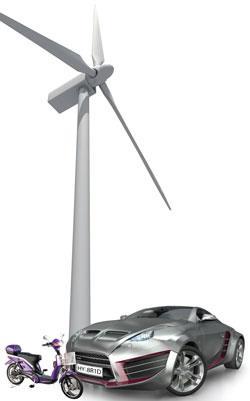
Why? The magnets contain neodymium, a rare earth element. These elements - the 15 lanthanides plus scandium and yttrium - are not actually all that rare, at least not in their geological states. They are found in many regions around the world, albeit in isolated pockets. China accounts for 96% of supply, despite laying claim to just 37% of accessible reserves. And in recent years, the country has dramatically reduced export quotas and production. Meanwhile, global demand for a range of products that incorporate neodymium magnets, including electric bicycles, consumer electronics, disk drives, hybrid cars and wind turbines has increased, explains Walt Benecki, a magnet industry consultant. This trend has been exacerbated by stockpiling by some countries and speculation on the markets.
Benecki predicts that new sources of neodymium oxide under development in Australia, South Africa and the US will begin to provide some relief in the next 12 to 24 months. In addition, other industries are looking at alternative materials. Toyota has announced plans to eliminate neodymium-based motors in its hybrid cars. Meanwhile, General Electric is evaluating superconductor technology so that it might remove neodymium from its wind turbines.
But despite such measures, demand is likely to exceed supply for the next three to four years and as a result the extraordinarily high prices are probably here to stay. ’This will likely have a significant negative impact on the commercialisation plans of magnetic refrigeration proponents,’ Benecki says.
BASF’s Rogge is more optimistic. ’The high price of magnets is certainly having an impact on magnetic cooling,’ he says. ’However, with the right materials and an intelligent design of systems, the cost of the magnet should not be prohibitive.’
Wilson agrees. ’The biggest thing to change since we started developing the technology is really the price of permanent magnets.’ Camfridge has already to some extent insulated its technology from this effect. High performance permanent magnets often incorporate dysprosium, which improves the properties but hikes up the cost because dysprosium is even more expensive than neodymium.
The magnets for the Camfridge units do not contain dysprosium and the team has kept low the amount of magnetic material needed by keeping high the operating frequency of the unit. The magnets don’t need to be so powerful if you can hustle through the cooling cycle faster, cramming more full cycles into the same amount of time, he explains.
But Camfridge still needs 1kg of NdFeB material for the permanent magnet - plus 100g of LaFeSi material for the MC components - per domestic fridge. And this means it needs to position its product in a part of the market where cost is less of an issue.
Magnetic cooling, at least as it is now, isn’t right for every cooling device. A typical domestic fridge is only about 10-15% efficient, says Wilson. A magnetic cooling unit will make it more like 20-30 % efficient, cutting the energy consumption in half. But other cooling devices are more efficient to begin with. A large industrial freezer, for example, is likely to be much more efficient, and as such a magnetic cooling unit is unlikely to make much difference.
But the potential payoff is nonetheless considerable. Wilson says the global market for domestic fridges is worth $10 billion per year.
Furthermore, there is evidence that people migrate to the most efficient models over only a few years. ’Within about three or four years of the introduction of a new higher efficiency appliance, that has become either the best or the second best selling product,’ Wilson says. People don’t replace their fridges that often. But when they do, they tend to go for a high efficiency model. As such, Wilson says he expects the A+++ category to reach 30-50% of the domestic fridge market within the next three to five years - a very cool prospect.
References
1 E Warburg, Ann. Phys. (Berlin, Ger.), 1881, 249, 141 (DOI: 10.1002/andp.18812490510)
2 V K Pecharsky and K A Gschneidner, Appl. Phys. Lett., 1997, 70, 3299 (DOI: 10.1063/1.119206)
3 V K Pecharsky and K A Gschneidner, J. Magn. Magn. Mater., 1997, 167, L-179 (DOI: 10.1016/S0304-8853(96)00759-7)
4 K A Gschneidner and V K Pecharsky, Int. J. Refrig., 2008, 31, 945 (DOI: 10.1016/j.ijrefrig.2008.01.004)
5 O Tegus et al, Nature, 2002, 415, 150 (DOI: 10.1038/415150a)
6 A Fujita et al, Phys. Rev. B, 2003, 67, 104416 (DOI: 10.1103/PhysRevB.67.104416)






No comments yet